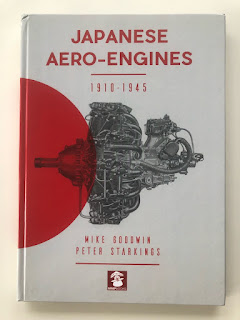Woody Kubacki has very kindly shared these images and details of his meticulous build of the Hasegawa Ki-44-II Shoki 'Tojo' kit (# 09137) to replicate the unusual scheme depicted by Ronnie Olsthoorn as Profile # 4 in Osprey Aircraft of the Aces 100 'Ki-44 Tojo Aces of World War 2', an early Ki-44-I of Hiko Dai 33 Sentai in China during early 1943. Apart from the blue grey camouflage this aircraft had unusual fuselage hinomaru consisting of a central red disk with aluminium border 0.5" wide, then a 2.75" wide yellow border with another 0.5" aluminium border outwith that, presumably the result of careful masking. The rear fuselage senchi hiyoshiki was 4". wide with 0.5" wide blue edging, the tail insignia blue-black but perhaps originally blue.
Woody describes his build as follows:-
'The build started off with the cockpit, with the kit seat being thinned down and the holes drilled out. Seat belts were created using Tamiya tape and lead wire and rudder pedal straps were added using thin strips of styrene.

'Next the cockpit was painted in AK Real Color IJA#3 Hairanshoku (AK R329)
'Ignition wires were added to the engine and the engine was painted aluminum and given a wash of Tamiya Panel liner black and dark brown.
'The fuselage was then closed up and the wings attached. Only slight filling was required before the plane was primed with Gunze Mr Surfacer 1500 and any imperfections in the bodywork were identified and corrected. The aotake was simulated by spraying an aluminium paint first and then spraying a mix of clear green and blue over that and finally a flat varnish to dull the shine.
Mr Color C76 on the left, custom mix on the right
'The model was then sprayed with an aluminium metallic paint (Gunze Mr Color SM 206 Super Chrome Silver), and then a marble coat was sprayed overtop.
'Next was the tricky masking of the fuselage hinomaru, leaving a 0.5 mm ring or aluminium, then a 1 mm yellow ring and finally a 0.5mm ring of aluminium.
'Then the base medium grey was sprayed over the entire aircraft, using Gunze C35 IJN Grey (Mitsubshi) in this case. Gunze Mr Color C125 Cowling Color was sprayed for the anti glare strip and C58 for the orange-yellow leading edge ID bands. National and tail markings were masked using Oramask 813 and sprayed with Gunze Mr Color C327 Red FS 11136 (which is as close a paint as I could find that matches their C385 Red (IJN Aircraft Marking) .
'Finally the most challenging part of the build, the mottle. I mixed a dark blue grey paint (5 parts Tamiya LP-13 IJN Grey (Sasebo Arsenal) and 1 part Gunze C71 Midnight blue) and proceeded to mottle the aircraft. Tail markings were painted in C71 Midnight blue, the remainder of the markings were painted and decals applied. Finally, the plane was chipped and weathered with Tamiya Panel liner and oil paints.'


After a fairly critical appraisal of the Ki-44 pre-production fighters in operations over Malaya and Burma with Dokuritsu Hiko Dai 47 Chutai at the beginning of the Pacific War, the Koku Hombu authorised the limited production of a further 40 aircraft, considering the type suitable as an anti-bomber and interceptor fighter. In December 1942, pursuant to a temporary defensive policy in China, the China Expeditionary Army was to arrange for the deployment of the Shoki (Type 2 single-seater fighter*) to each of the frontline airfields in north, central and south China as soon as possible. The first operational unit to receive the Shoki was the 33rd Sentai, then based at Canton and equipped with the Nakajima Ki-43 Hayabusa 'Oscar' (Type 1 fighter). Only five Shoki were delivered to the unit during the autumn of 1942 or early in 1943 and they equipped a special shotai (flight) formed for air defence duties over the Wuchang area in central China. The air defence posture for the Shoki did not last long in China and it was soon being used offensively, pioneering the hit and run tactics developed by its champions at Akeno and coming as an unpleasant surprise to Chennault's flyers.
With very special thanks to Woody for sharing the images and details, with more to come.
* The Type 2 designation has caused some confusion as the Kawasaki Ki-45 Toryu 'Nick' was designated the Type 2 Two-seater Fighter, resulting in the Ki-44 sometimes being attributed to units which operated the twin-engined fighter.
Image credit: All photos © 2021 Woody Kubacki






















































